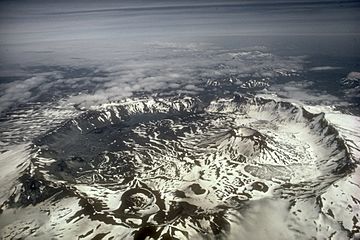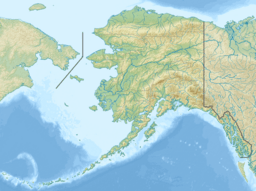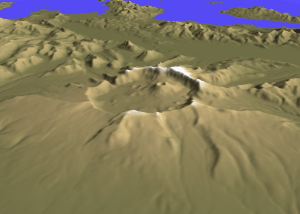Mount Aniakchak facts for kids
Quick facts for kids Aniakchak Caldera |
|
|---|---|

Mount Aniakchak caldera
|
|
| Highest point | |
| Elevation | 4,232 ft (1,290 m) |
| Geography | |
| Location | Aniakchak National Monument and Preserve, Alaska, U.S. |
| Parent range | Aleutian Range |
| Topo map | USGS Chignik D-1 |
| Geology | |
| Mountain type | Caldera (Stratovolcano) |
| Volcanic arc/belt | Aleutian Arc |
| Last eruption | May to June 1931 |
| Designated: | November 1967 |
Mount Aniakchak is a huge volcanic caldera in Alaska, U.S.. It's like a giant bowl-shaped crater, about 10 kilometers (6 miles) wide. This amazing natural feature is located in the Aleutian Range.
Aniakchak was once a tall, cone-shaped stratovolcano. But about 3,700 years ago, it had a massive eruption. This powerful event caused the volcano's top to collapse, forming the caldera we see today. The area around the volcano is now protected as the Aniakchak National Monument and Preserve. It's managed by the National Park Service. In 1967, Aniakchak Caldera was named a National Natural Landmark.
Contents
How Aniakchak Formed
Before it collapsed, Mount Aniakchak was a large volcano. It was made of different types of volcanic rock. About 3,700 years ago, a huge eruption happened. This eruption was so strong that the volcano's top fell in. This created the big caldera.
Scientists found evidence of this eruption in ice cores. These are long samples of ice from places like Greenland. They show layers of ash from past eruptions. The ash from Aniakchak's big eruption dates back to around 1641 BC. Some scientists think it might have been a few years later, around 1628 BC.
Since that giant eruption, more than 20 smaller eruptions have happened. These came from vents, or openings, on the caldera floor. One main vent is called Vent Mountain. It has erupted many times, sending out ash, rocks, and lava.
Between 1500 BC and AD 1000, four lava domes formed inside the caldera. These domes are like mounds of thick lava. They formed under an ancient lake called Ancient Surprise Lake. This lake was once very deep, about 100 meters (328 feet).
Around AD 1000, Ancient Surprise Lake drained away very quickly. After this, some explosive eruptions happened. They created three cone-shaped hills made of volcanic ash.
Around AD 1500, Aniakchak had another very strong eruption. It destroyed a part of the caldera called Half Cone. This eruption covered most of the caldera floor with hot ash and rock. A lava flow then filled the area where Half Cone had collapsed.
More recent eruptions also happened near Vent Mountain. They created a small cinder cone and two water-filled craters.
Aniakchak's Recent Eruptions
Geologists from Europe first found the volcano in 1922.
The only eruption in modern times happened in 1931. A Jesuit priest named Father Bernard R. Hubbard recorded it. He described a "small but impressive explosion pit" forming. Thousands of tons of ash were spread inside the caldera. Ash also fell up to 40 miles away, reaching small villages.
Aniakchak and Human History
The huge eruption about 3,700 years ago changed the land a lot. It affected plants and animals over a wide area. This eruption also had a big impact on people living in western Alaska.
The area right around the volcano was so damaged that people didn't return for about 2,000 years. Some experts think this eruption might have separated groups of people. This separation could have led to the different languages spoken by the Aleutian and Eskimoan people today.
Surprise Lake
Inside the caldera is Surprise Lake. This lake is the source of the Aniakchak River. The Aniakchak River is a special waterway. It is known as a National Wild River.
Images for kids
See also
 In Spanish: Monte Aniakchak para niños
In Spanish: Monte Aniakchak para niños





